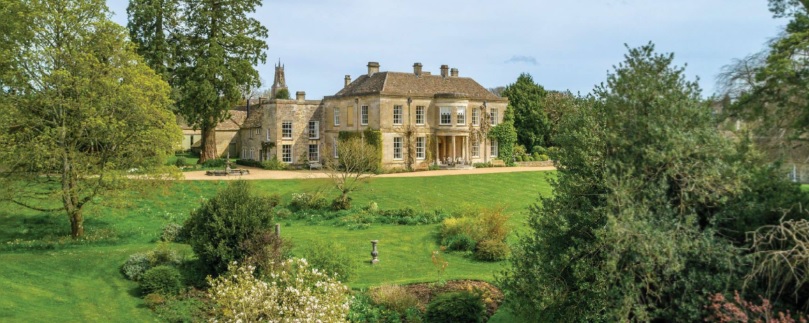
WHEN the invading Roman army arrived in the Cotswolds some 2,000 years ago, they found a region of gentle hills, valleys and streams and a climate of chilly winters and springs. They brought hardy sheep to raise for wool to keep themselves warm and, when they left, the flocks passed into the hands of local landowners: first the Church and then local families. In the Middle Ages, sheep grazed the hills and valleys of the Cotswolds, fleeces from a million Cotswold longwool sheep were traded and fortunes were made. Rich merchants created a landscape dotted with the lofty spires of wool churches and marketplaces surrounded by grand townhouses.
The coming of the Industrial Revolution in the mid 1700s saw the emergence of Stroud and its surrounding valleys in the southwestern Cotswolds as a focal point of the industry, thanks to its many fast-flowing rivers that, at one point, powered some 170 mills in the area. The ancient market town of Minchinhampton, which stands on a hilltop four miles south-east of Stroud, derives its name from the Old English heatun meaning 'high town' and mynecen, meaning 'nun', having been granted by William the Conqueror to the Convent of the Holy Trinity at Caen, Normandy, in 1066. The Norman nuns held Minchinhampton for more than 300 years until, in 1415 (the year of Agincourt), the Crown confiscated all foreign-held ecclesiastical assets. The manor of Minchinhampton was later transferred to the Brigittine Abbey of Syon in Middlesex, which remained in possession until the Dissolution in 1534.
Grade II*-listed The Lammas, a classic, Georgian house set in more than five acres with mature trees and wonderful valley views, is on the site of or near the manor acquired by the Minchinhampton nuns. Rupert Sweeting of Knight Frank (07836 260236) and Ed Sugden of Savills (07557 337507) are joint agents for its sale, for which they quote a guide price of $7.5 million.
Esta historia es de la edición May 08, 2024 de Country Life UK.
Comience su prueba gratuita de Magzter GOLD de 7 días para acceder a miles de historias premium seleccionadas y a más de 9,000 revistas y periódicos.
Ya eres suscriptor ? Conectar
Esta historia es de la edición May 08, 2024 de Country Life UK.
Comience su prueba gratuita de Magzter GOLD de 7 días para acceder a miles de historias premium seleccionadas y a más de 9,000 revistas y periódicos.
Ya eres suscriptor? Conectar

Save our family farms
IT Tremains to be seen whether the Government will listen to the more than 20,000 farming people who thronged Whitehall in central London on November 19 to protest against changes to inheritance tax that could destroy countless family farms, but the impact of the good-hearted, sombre crowds was immediate and positive.

A very good dog
THE Spanish Pointer (1766–68) by Stubbs, a landmark painting in that it is the artist’s first depiction of a dog, has only been exhibited once in the 250 years since it was painted.

The great astral sneeze
Aurora Borealis, linked to celestial reindeer, firefoxes and assassinations, is one of Nature's most mesmerising, if fickle displays and has made headlines this year. Harry Pearson finds out why

'What a good boy am I'
We think of them as the stuff of childhood, but nursery rhymes such as Little Jack Horner tell tales of decidedly adult carryings-on, discovers Ian Morton

Forever a chorister
The music-and way of living-of the cabaret performer Kit Hesketh-Harvey was rooted in his upbringing as a cathedral chorister, as his sister, Sarah Sands, discovered after his death

Best of British
In this collection of short (5,000-6,000-word) pen portraits, writes the author, 'I wanted to present a number of \"Great British Commanders\" as individuals; not because I am a devotee of the \"great man, or woman, school of history\", but simply because the task is interesting.' It is, and so are Michael Clarke's choices.

Old habits die hard
Once an antique dealer, always an antique dealer, even well into retirement age, as a crop of interesting sales past and future proves

It takes the biscuit
Biscuit tins, with their whimsical shapes and delightful motifs, spark nostalgic memories of grandmother's sweet tea, but they are a remarkably recent invention. Matthew Dennison pays tribute to the ingenious Victorians who devised them

It's always darkest before the dawn
After witnessing a particularly lacklustre and insipid dawn on a leaden November day, John Lewis-Stempel takes solace in the fleeting appearance of a rare black fox and a kestrel in hot pursuit of a pipistrelle bat

Tarrying in the mulberry shade
On a visit to the Gainsborough Museum in Sudbury, Suffolk, in August, I lost my husband for half an hour and began to get nervous. Fortunately, an attendant had spotted him vanishing under the cloak of the old mulberry tree in the garden.